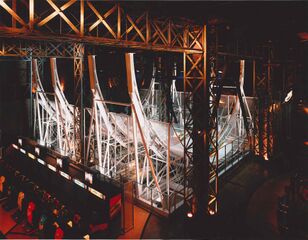Difference between revisions of "Halfpipe Canyon"
From Sega Retro
| Line 3: | Line 3: | ||
| publisher=[[Sega]] | | publisher=[[Sega]] | ||
| developer=[[Sega AM5]] | | developer=[[Sega AM5]] | ||
| − | | system=Large attraction | + | | system=[[Large attraction]] |
| players=2-4 (original), 4-8 (''Halfpipe Tokyo'') | | players=2-4 (original), 4-8 (''Halfpipe Tokyo'') | ||
| genre= | | genre= | ||
| Line 40: | Line 40: | ||
==References== | ==References== | ||
<references/> | <references/> | ||
| + | |||
| + | {{clear}} | ||
| + | {{LargeAttractions}} | ||
[[Category:Large attractions]] | [[Category:Large attractions]] | ||
Revision as of 07:43, 11 May 2021

| |||||
| Halfpipe Canyon | |||||
|---|---|---|---|---|---|
| System(s): Large attraction | |||||
| Publisher: Sega | |||||
| Developer: Sega AM5 | |||||
| Number of players: 2-4 (original), 4-8 (Halfpipe Tokyo) | |||||
|
This teeny-tiny article needs some work. You can help us by expanding it.
Halfpipe Canyon (ハーフパイプキャニオン) is an attraction created by Sega AM5 in 1996 for its flagship theme park, Tokyo Joypolis. In 2009, the ride was also installed as a major attraction at Sega Republic.[1]
Contents
Gameplay
Two teams of two riders each strap onto a large "skateboard", which swings back and forth on a 7 meter tall halfpipe at speeds of 40 km/h. As with all Sega rides, Halfpipe Canyon includes an interactive element: when the skateboard reaches the top of its swing, teams gain points for stomping left-right-left-right on the board's footpedals in sychronization. If the players time their stomps correctly, the board does a 360 degree spin, and the team wins points. At the end of the ride, the team with the most points wins.[2]
History
Halfpipe Tokyo
In 2012, the Halfpipe Canyon ride at Tokyo Joypolis was revamped as part of major renovations to the park. The new version of the ride is called Halfpipe Tokyo (ハーフパイプ トーキョー) and features futuristic LED accents, large LCD screens for displaying scores and videos, and a fast-paced electronic soundtrack consisting of songs by famous dojin artists, including Masayoshi Minoshima, members of IOSYS, Tsukasa, zts and others.[3]
An official soundtrack album for the ride was released by Joypolis as a digital download on Amazon and iTunes, combined with songs from the arcade title Maimai GreeN, which shares much of Halfpipe Toyko's music.[4] Halfpipe Tokyo also doubles the capacity of the original Halfpipe Canyon, allowing four teams to play simultaneously.
Magazine articles
- Main article: Halfpipe Canyon/Magazine articles.
Artwork
Photo gallery
Halfpipe Canyon at Sega Republic.
References
- ↑ http://blogs.sega.com/2009/08/21/sega-republic-opens-in-dubai/
- ↑ https://towersstreet.com/talk/threads/arabian-adventure-ferarri-world-more.3372/
- ↑ http://www.joshuatly.com/halfpipe-tokyo-sega-tokyo-joypolis-part-2/
- ↑ https://www.amazon.com/HALFPIPE-Original-Soundtrack-Various-artists/dp/B00ADKS3VA/




